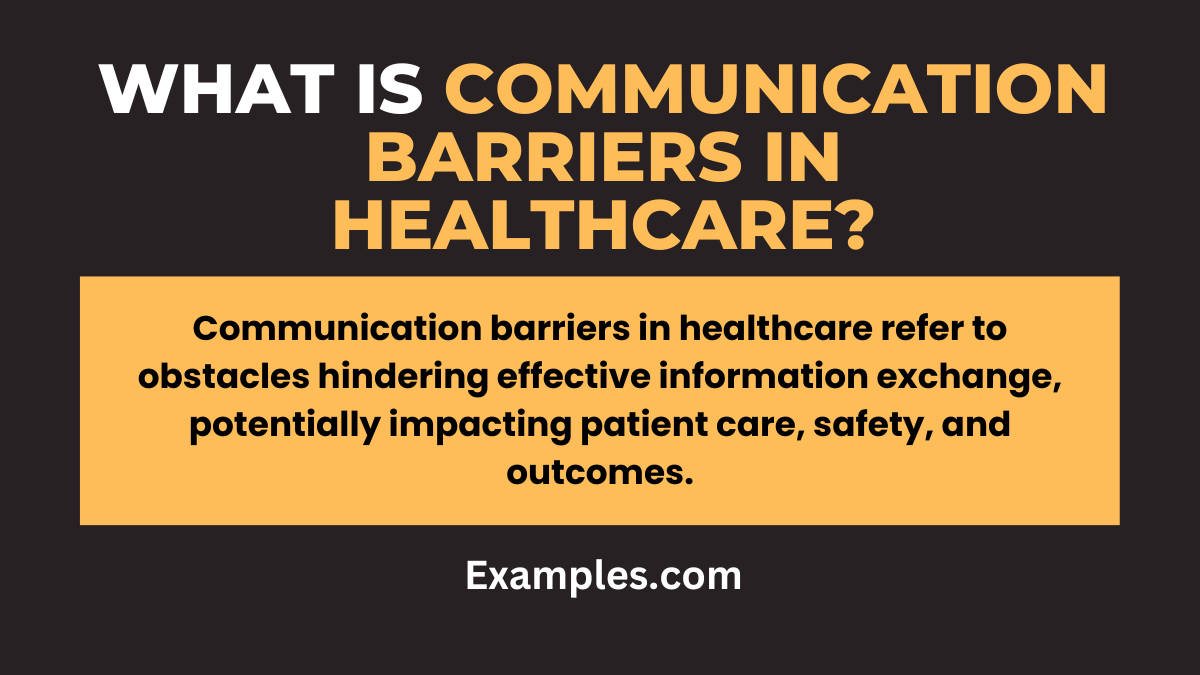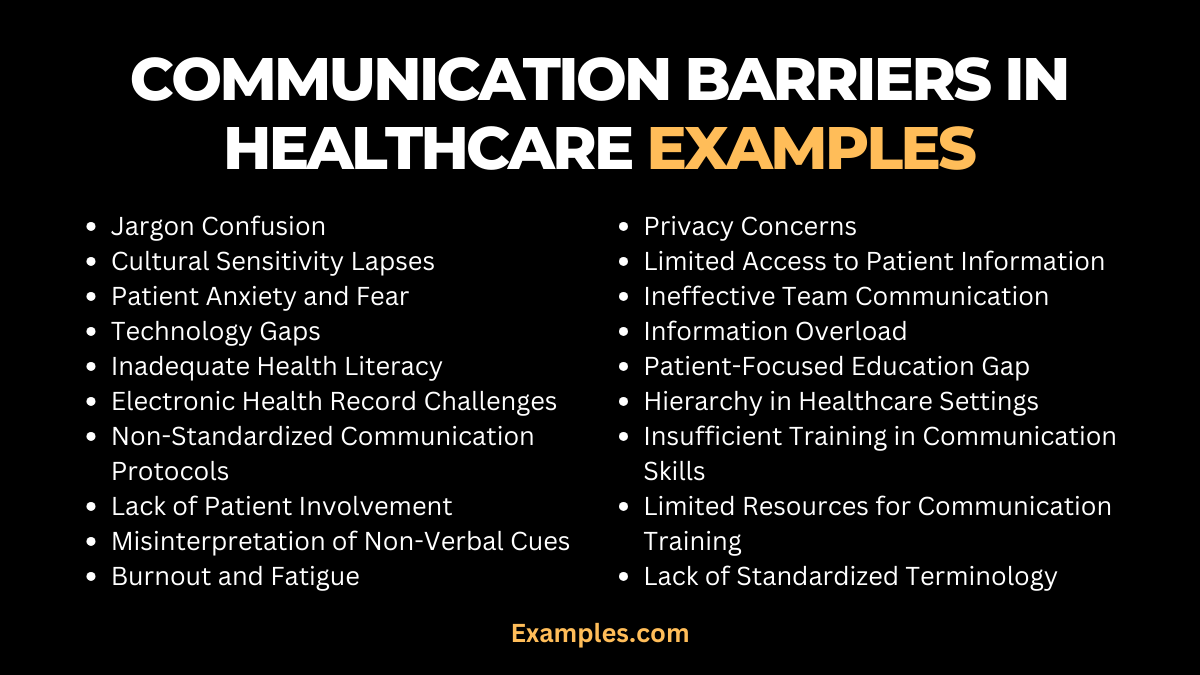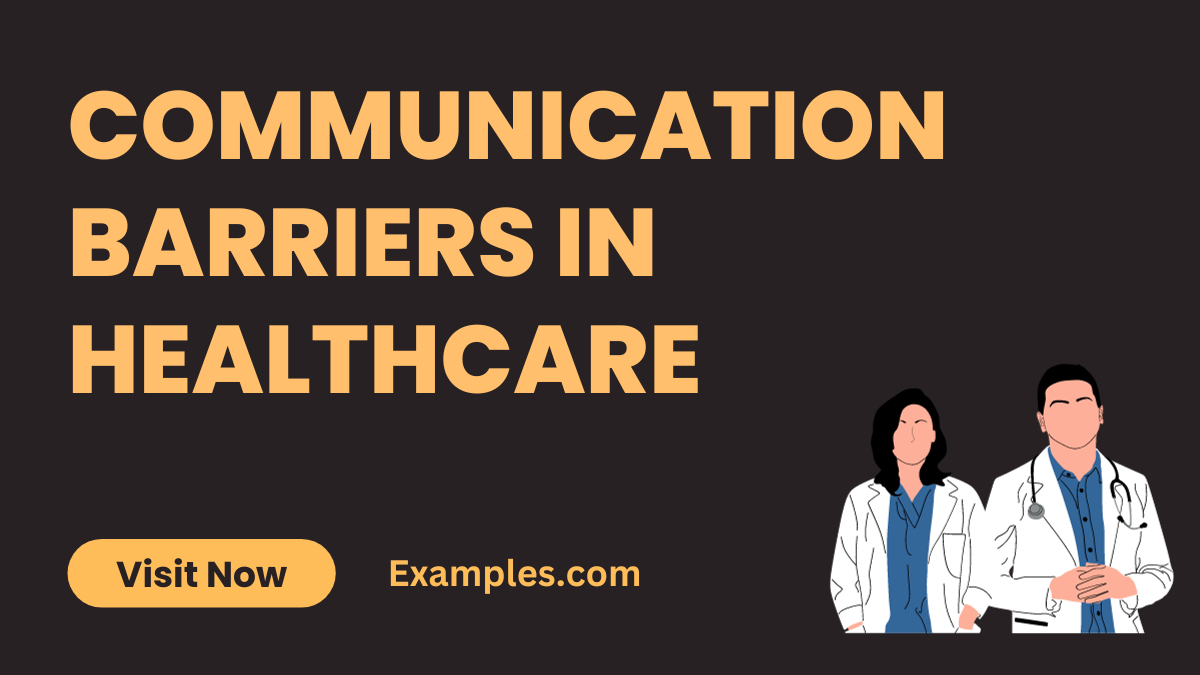29+ Communication Barriers in Healthcare Examples
Navigate the intricate landscape of healthcare communication barriers with our comprehensive guide. Unveil the nuances through vivid Communication Examples, gaining insights into the challenges, effects, and actionable solutions for fostering seamless interactions in the healthcare domain. Empower your understanding to enhance patient care and collaboration among healthcare professionals. Unlock the secrets to effective communication in healthcare with our insightful guide.
What is Communication Barriers in Healthcare?

Communication barriers in healthcare refer to obstacles that impede the effective exchange of information among healthcare professionals, impacting patient care. These hurdles may include language differences, misinterpretation of medical jargon, and inadequate information flow, hindering collaboration and potentially compromising patient outcomes. Identifying and addressing these barriers is crucial for ensuring clear, accurate, and timely communication within the healthcare system.
Best Example of Communication Barriers in Healthcare: Unveiling Medication Misunderstanding
One prominent example of communication barriers in healthcare involves medication misunderstanding. When healthcare professionals and patients fail to comprehend prescription details due to complex language or insufficient explanation, it can lead to dosage errors or treatment mismanagement. These barriers can arise from various sources, including physical barriers to communication, such as environmental noise, and language barriers to communication, where differences in language or dialect impede understanding.
30 Communication Barriers in Healthcare Examples

Explore diverse healthcare communication hurdles, from language disparities to technology gaps, hindering optimal patient care. Our list dives into 10 unique examples, delving into the causes behind each barrier and offering actionable solutions. A prevalent issue in healthcare communication is the medication misunderstanding Communication Barriers with Elderly and Communication Barriers with Dementia Patients includes generational differences in communication styles and potential hearing impairments, a consequence of complex medical jargon and insufficient explanations, leading to errors in treatment.Elevate healthcare interactions, foster patient understanding, and fortify collaboration among healthcare professionals for a more streamlined and patient-centric healthcare experience.
- Jargon Confusion:
- Cause: Medical terminology complexity.
- Fix: Simplify language, provide explanations.
- Cultural Sensitivity Lapses:
- Cause: Insufficient cultural awareness.
- Fix: Incorporate diversity training, promote cultural sensitivity.
- Patient Anxiety and Fear:
- Cause: Emotional barriers in healthcare.
- Fix: Foster empathy, create a supportive environment.
- Technology Gaps:
- Cause: Issues in adopting technology.
- Fix: Provide training, enhance tech accessibility.
- Inadequate Health Literacy:
- Cause: Difficulty understanding medical information.
- Fix: Utilize plain language, offer educational materials.
- Electronic Health Record Challenges:
- Cause: Access and usability issues.
- Fix: Streamline systems, provide user-friendly interfaces.
- Non-Standardized Communication Protocols:
- Cause: Lack of uniform procedures.
- Fix: Establish clear communication guidelines.
- Lack of Patient Involvement:
- Cause: Limited patient engagement.
- Fix: Encourage shared decision-making, involve patients.
- Misinterpretation of Non-Verbal Cues:
- Cause: Challenges in understanding cues.
- Fix: Enhance non-verbal communication awareness.
- Burnout and Fatigue:
- Cause: Exhaustion affecting communication.
- Fix: Implement support programs, prioritize well-being.
- Privacy Concerns:
- Cause: Fears regarding confidentiality.
- Fix: Emphasize data security measures, communicate policies.
- Limited Access to Patient Information:
- Cause: Challenges in obtaining comprehensive data.
- Fix: Implement integrated systems, ensure data accessibility.
- Ineffective Team Communication:
- Cause: Poor collaboration among professionals.
- Fix: Foster teamwork, encourage open communication.
- Information Overload:
- Cause: Overwhelming medical information.
- Fix: Prioritize and deliver information in digestible portions.
- Patient-Focused Education Gap:
- Cause: Insufficient efforts in patient education.
- Fix: Develop clear educational materials, engage patients proactively.
- Hierarchy in Healthcare Settings:
- Cause: Communication challenges due to organizational hierarchy.
- Fix: Promote open communication channels, bridge hierarchical gaps.
- Insufficient Training in Communication Skills:
- Cause: Lack of proper communication training.
- Fix: Incorporate communication skills training in healthcare education.
- Limited Resources for Communication Training:
- Cause: Inadequate resources for enhancing skills.
- Fix: Advocate for increased training resources, explore online training options.
- Lack of Standardized Terminology:
- Cause: Inconsistency in using medical terms.
- Fix: Establish standardized terminologies, provide guidelines.
- Distractions in Healthcare Settings:
- Cause: External factors hindering communication.
- Fix: Create dedicated communication spaces, minimize disruption.
- Language Barriers:
- Cause: Communication difficulties due to language diversity.
- Fix: Provide translation services, employ multilingual staff.
- Mismatched Expectations:
- Cause: Divergence in patient and provider expectations.
- Fix: Establish clear expectations, encourage open dialogue.
- Stigma and Discrimination:
- Cause: Biases affecting patient-provider relationships.
- Fix: Implement anti-discrimination policies, educate staff.
- Inadequate Time with Patients:
- Cause: Limited time for thorough communication.
- Fix: Optimize scheduling, prioritize communication time.
- Role Ambiguity:
- Cause: Unclear delineation of responsibilities.
- Fix: Define roles clearly, encourage teamwork.
- Inaccessible Communication Channels:
- Cause: Limited avenues for patient communication.
- Fix: Expand communication options, utilize digital platforms.
- Resistance to Patient Feedback:
- Cause: Unwillingness to accept patient input.
- Fix: Encourage feedback, implement patient satisfaction surveys.
- Lack of Emotional Support:
- Cause: Insufficient emotional care provision.
- Fix: Integrate counseling services, prioritize emotional well-being.
- Inadequate Informed Consent Process:
- Cause: Lack of clarity in the consent process.
- Fix: Enhance consent communication, ensure comprehension.
- Public Health Communication Gaps:
- Cause: Challenges in conveying public health messages.
- Fix: Develop targeted communication strategies, involve communities
Barriers to Effective Communication in Healthcare
Effective communication in healthcare is vital for ensuring quality patient care and safety. However, various barriers often hinder this process, leading to misunderstandings and potentially compromising patient outcomes. Crucially, Self Barriers in Communication also play a role, where personal biases or lack of confidence can hinder effective dialogue. ddressing these issues is crucial for healthcare providers to facilitate better understanding, patient engagement, and collaborative care.
- Information Exchange Challenges: Suboptimal information exchange in healthcare can have dire consequences on patient safety and care. Communication errors are often cited as a major factor in adverse events, requiring thorough analysis to pinpoint specific breakdowns??.
- Medium of Communication: Choosing the wrong medium to convey healthcare information can lead to misunderstandings. Not all patients can comprehend complex medical instructions, necessitating the use of more accessible formats like animations or visual aids??.
- Message Design: The way healthcare messages are crafted is critical. Avoiding medical jargon and complex words ensures the message is understandable to patients without a medical background??.
- Physical or Biological Barriers: Communicating with patients who have conditions like Alzheimer’s or disabilities requires tailored approaches, such as slow speech or alternative formats like podcasts for those with poor eyesight??.
- Language Barriers: Misinterpretation of words, use of medical jargon, and varying meanings in different contexts can create significant barriers. Clear and contextually accurate communication is essential??.
- Personal Barriers: Differences in personal and psychological makeup between patients and healthcare providers can create barriers. Understanding the patient’s perspective on their health is crucial for effective communication??.
- Emotional Barriers: Emotional states like fear or anxiety can hinder effective communication in healthcare, especially in sensitive areas such as sexual and reproductive health??.
Types of Communication Barriers in Healthcare
In healthcare settings, communication barriers can significantly impact the delivery of care. These barriers include language and cultural differences, emotional and psychological factors, and technological and organizational challenges. The inclusion of Information Overload in Communication and Organizational Barriers to Communication adds complexity to these challenges. Understanding these barriers is the first step towards improving communication and enhancing patient care.
- Socio-Psychological Barriers: Selective perception and the halo effect, where patients’ previous experiences or fears influence their reception of healthcare information, can be significant barriers??.
- Cultural Barriers: Cultural differences can affect how patients perceive and engage with healthcare information, necessitating culturally sensitive communication strategies??.
- Channel Flow Barriers: Misuse of communication channels or over-reliance on certain mediums can lead to information being misunderstood or missed altogether??.
- Technological Barriers: Inadequate or inappropriate use of technology in communication can lead to gaps in understanding and accessibility.
- Environmental Barriers: The physical setting or environment in which communication occurs can impact its effectiveness, such as noisy or crowded healthcare settings.
- Organizational Barriers: Hierarchical structures and organizational culture within healthcare settings can impede open and effective communication.
- Interpersonal Barriers: Personal biases, attitudes, and behaviors of healthcare providers can create barriers in effectively communicating with patients.
Dissecting Communication Barriers in Healthcare
Exploring the various communication barriers in healthcare reveals a complex landscape of challenges that healthcare professionals encounter daily. Addressing Barriers of Therapeutic Communication and Disability Barriers to Communication is also critical. Delving into these barriers allows for a better understanding of their origins and implications, fostering strategies to enhance communication effectiveness in the healthcare sector.
- Understanding Patient Needs: Recognizing the specific needs and backgrounds of patients is crucial for overcoming communication barriers.
- Adapting to Patient Literacy Levels: Tailoring communication to match the literacy and comprehension levels of different patients is essential.
- Acknowledging Emotional States: Being aware of and responsive to the emotional states of patients during communication.
- Addressing Cultural Differences: Recognizing and respecting cultural differences in communication styles and preferences.
- Utilizing Technology Appropriately: Leveraging technology effectively to enhance, not hinder, communication.
- Environmental Adjustments: Making environmental changes to facilitate better communication, like reducing noise or ensuring privacy.
- Overcoming Organizational Challenges: Addressing and mitigating communication barriers that arise from organizational culture and structure.
Barriers to Communication in Healthcare and How to Overcome Them
In healthcare, communication barriers not only hinder the exchange of information but also affect patient outcomes and the efficiency of care delivery. Additionally, Communication Barriers in Nursing often stem from high workloads and diverse patient demographics, necessitating targeted strategies for improvement.From Perceptual Barriers to Communication affecting how information is interpreted to the Lack of Trust as a Communication Barrier, these obstacles can lead to significant miscommunications. Defensiveness or Premature Assumptions, Different Communication Styles, and Disengagement in Communication further complicate interactions. Delving into these barriers enhances understanding of their origins and implications, supporting strategies to improve communication effectiveness in healthcare.
- Enhance Communication Training: Providing comprehensive training for healthcare professionals to improve communication skills, including dealing with diverse patient populations????.
- Use of Visual Aids and Technology: Incorporating visual aids and appropriate technology to assist in explaining complex medical terms and procedures??.
- Culturally Sensitive Communication: Developing and implementing culturally sensitive communication strategies to address the diverse needs of patients??.
- Active Listening and Empathy: Encouraging healthcare providers to practice active listening and show empathy towards patients.
- Feedback Mechanisms: Establishing feedback systems to continuously improve communication strategies based on patient and staff input.
- Collaborative Communication: Promoting collaborative communication approaches that involve patients in decision-making processes.
- Regular Training and Evaluation: Regularly evaluating and updating communication training programs to keep pace with the changing healthcare environment and patient demographics.
By addressing these barriers and implementing effective strategies, healthcare providers can significantly improve communication, Generational Barriers in Communication highlight the need for sensitivity to different age groups’ communication preferences. leading to better patient outcomes and enhanced overall healthcare delivery.
What are the barriers to communication with patients in healthcare?
Barriers in healthcare communication include language differences, emotional states, cultural disparities, technological gaps, environmental factors, organizational structures, and interpersonal dynamics.
What are communication challenges in healthcare?
Challenges in healthcare communication encompass managing patient diversity, overcoming language and cultural differences, adapting to technological advancements, and navigating complex organizational hierarchies.
Effective communication in healthcare is hindered by diverse barriers like cultural and language differences, emotional and psychological factors, and organizational challenges. Addressing these barriers is crucial for enhancing patient care and safety.



